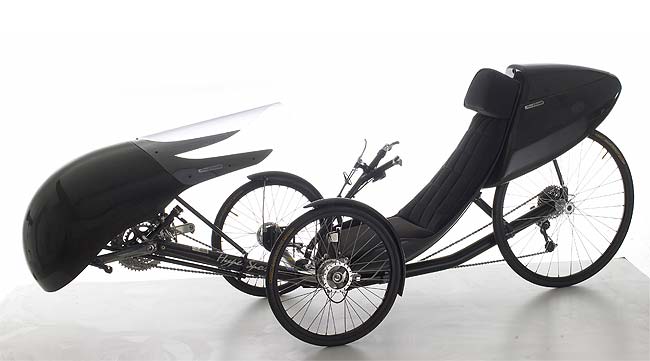Recumbents can be faster. As was previously mentioned, all of the land speed records for human powered vehicles were set with fully faired recumbents (velomobiles).
But what will really make the difference is the rider.
Consider this rider you've never heard of, Andy Wilkinson. In 1990 he broke the record for fastest bicycle trip from Lands End to John O'Groats, 874 miles (1,407 km), at 45 hours 2 minutes 19 seconds, on a bicycle. In 1996 he did the same trip again, this time in a fully faired recumbent, and broke his own record, coming in at 41 hours 4 minutes 22 seconds. (This number is unofficial because it didn't take place on a two wheeled bicycle, but no one else has yet beaten this time...)
On that ride he occasionally exceeded 75 mph (120 km/h) on descents. And that was a nearly 20 year old machine. The typical top end recumbent of today is much more technologically advanced, and is usually partially faired.

Recumbents also do very well in time trials and ultramarathon events such as the Race Across America.
But how will it do for your commute?
Not all recumbents are designed for road racing, of course. The things you want to look for which will improve your ride both on roads and forest trails in all weather include:
- A larger rear wheel
- Rear suspension (or all-wheel suspension, rare)
- High ground clearance
- The ability to mount fatter tires
- Fenders (which also fit around the tires!)
Some current (2015 model year) possibilities include:
The Gekko from HP Velotechnik uses a 26 inch rear wheel to help with obstacles you might run over on the road or even forest trails. It also has an electric option. It also has higher ground clearance, to make it easier to clear obstacles.
Similarly the Catrike Expedition has higher ground clearance and a 26 inch wheel. This trike is often called the SUV of trikes. Or the Road which has a 20 inch rear wheel but also includes rear suspension.
The ICE Adventure 26 also has a 26 inch wheel and has high ground clearance; the seat is also much higher than many other trikes. It also includes rear suspension and has a front suspension option.
There are also other trikes for primarily off-road use, such as HPV's Enduro. And a modified ICE Sprint was used to ride to the South Pole, beating two bicycle riders. I suspect your forest trails are not quite so demanding as to make these reasonable for your commute, though.
I would suggest that you find a local bike (trike?) shop which specializes in recumbents, or perhaps several shops, and take them for test rides. Unless you have a very large recumbent dealer nearby, they may not have the exact model you are looking for in stock, so you may find yourself riding a similar model. Be prepared to travel if you want to test ride the perfect recumbent.
Finally, back to your original question. To ask it accurately, you must ask whether you will be faster on a recumbent trike! The answer is, maybe. Once you get your recumbent legs, which may take a month or two, you should be at about the same overall speed, give or take a km/h or two.
Whether you can go faster, well, that's entirely up to you. I expect you will find that the experience of riding the recumbent is so much more comfortable that you won't miss an extra minute or two - or just might even want to ride more!



